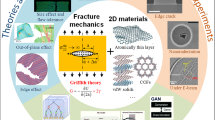Abstract
It has recently been shown that the techniques of EPR spectroscopy can be used to monitor atomic bond rupture during fracture of polymeric materials and thus provide important new insights of the molecular mechanisms of fracture in these materials. In particular, this method can be used as a fundamental check of the several atomistically-derived theories of polymer fracture. In this paper such a check is made of two representative such theories, those of S. N. Zhurkov and W. G. Knauss. It is shown that these theories do not provide physically realistic models of the fracture mechanisms in oriented polymeric fibers and it is suggested that their lack of relevance is due to the unique morphological structure of highly oriented polymers.
Résumé
On a montré récemment que les techniques de spectroscopie électronique a résonnance paramagnétique peuvent être utilisées avec succès pour la detection des ruptures des liaisons atomiques au cours de la rupture des matériaux polymeres; ces techniques ont permis de jeter de nouvelles lumières sur les mécanismes moléculaires qui interviennent au cours de la rupture de ces matériaux.
En particulier, la méthode permet de procéder a un controle, sur une base fondamentale, de quelques théories atomiques de la rupture des polymères.
Dans le présent mémoire, on procède à un tel controle de deux théeories des plus typiques, celles de Zhurkov et de Knauss.
On démontre que ces theories ne conduisent pas à des modèles physiquement représentatif du mécanisme de rupture des polymères à fibres orientées. On suggère que cette inadaptation résulte de la structure morphologique particulière des polymères à orientation marquée.
Zusammenfassung
Neuerdings wurde gezeigt, daß die Verfahren der elektronischen Spektroskopie erfolgreich für den Nachweis von Zerstörungen in den atomaren Bindungen während des Zerreissens von Polymeren herangezogen werden können. Sie führen somit zu wichtigen neuen Erkenntnissen über die molekularen Mechanismen der Zerstörung dieser Werkstoffe.
Im besonderen kann dieses Verfahren für eine grundlegende Kontrolle verschiedener atomistisch abgeleiter Theorien über den Bruch von Polymeren herangezogen werden. Im vorliegenden Bericht werden zwei dieser Theorien, nämlich diejenigen von S. N. Zhurkov and W. G. Krauss, überprüft.
Es wird gezeigt, daß these Theorien kein physikalisch realistisches Modell des Bruchmechanismus von Polymerfasern geben, and es wird vorgeschlagen diesen Mangel an Zutrefflichkeit durch die spezielle morphologische Struktur der streng gerichteten Fasern zu erklären.Major portions of this work were supported by the National Science Foundation and the National Aeonautics and Space Administration.
Similar content being viewed by others
References
S. N. Zhurkov, A. Y. Savostin and E. E. Tomashevskii, Electron Paramagnetic Resonance Study of the Polymer Degradation Mechanism. Soviet Physics-Doklady., 9 (1965) 986 (in English).
M. L. Williams and K. L. DeVries, An EPR Investigation of Newly Formed Fracture Surfaces. Proceedings of the 15th Sagamore Army Materials Research Conference, Raquette Lake, New York, August 22–25 (1967).
D. K. Roylance, K. L. DeVries and M. L. Williams, Fracture Detection in Polymers by Electron Paramagnetic Resonance, Fracture, Chapman and Hall, (1969).
G. S. P. Venna and A. Peterlin, EPR Studies of Free Radicals in Mechanically Loaded Nylon 66, Polymer Preprints, 10 (1969) 1051.
S. N. Zhurkov, Das Problem der Festigkeit fester Körper, Zeitschrift fur Physikalische Chemie, 231 (1960) 183.
S. N. Zhurkov, Kinetic Concept of the Strength of Solids, International Journal of Fracture Mechanics, 1 (1965) 311.
S. N. Zhurkov and E. E. Tomaskevskii, An Investigation of Fracture Processes of Polymers by Electron Spin Resonance Method, Conference Proceedings: Physical Basis of Yield and Fracture, Oxford (1966).
A. Tobdsky and H. OEyring, Mechanical Properties of Polymeric Materials, Journal of Chemical Physics, 11 (1943) 125.
D. C.Prevorsek, Tensile Strength of Oriented Polymers Below the Glass Transition Temperature, Journal of Polymer Science, Part A-2, 4 (1966) 63.
C. C. Hsaio, Fracture, Physics Today, 49 (March 1966).
W. G. Knauss, Rupture Phenomena in Viscoelastic Materials, Ph. D. dissertation, California Institute of Technology, Pasadena, Calif. (1963).
A. Peterlin, Mechanical Properties and Chain Folding in Fibers, Preprint no. 193, Camille Dreyfus Laboratory, Research Triangle Institute, North Carolina., March 1968.
K. L. DeVries and R. J. Farris, Strain Inhomogeneities, Molecular Chain Scission and Stress-Deformation in Polymers, UTEC DO 69-027. To be published in the International Journal of Fracture Mechanics.
Author information
Authors and Affiliations
Rights and permissions
About this article
Cite this article
Devries, K.L., Roylance, D.K. & Williams, M.L. An experimental investigation of some models of polymer fracture. Int J Fract 7, 197–202 (1971). https://doi.org/10.1007/BF00183806
Received:
Issue Date:
DOI: https://doi.org/10.1007/BF00183806




